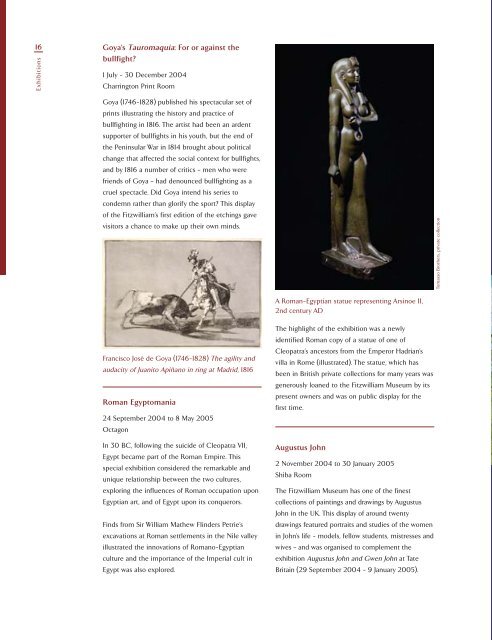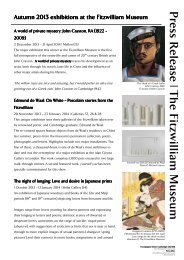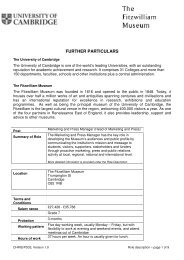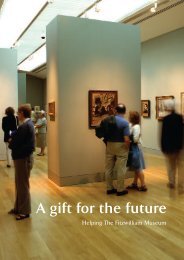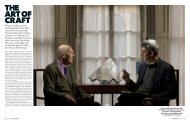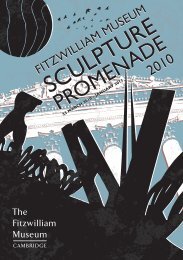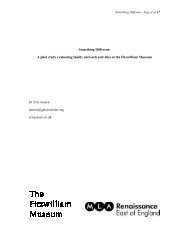The Fitzwilliam Museum - University of Cambridge
The Fitzwilliam Museum - University of Cambridge
The Fitzwilliam Museum - University of Cambridge
Create successful ePaper yourself
Turn your PDF publications into a flip-book with our unique Google optimized e-Paper software.
16 Goya’s Tauromaquia: For or against the<br />
bullfight?<br />
Exhibitions<br />
1 July - 30 December 2004<br />
Charrington Print Room<br />
Goya (1746-1828) published his spectacular set <strong>of</strong><br />
prints illustrating the history and practice <strong>of</strong><br />
bullfighting in 1816. <strong>The</strong> artist had been an ardent<br />
supporter <strong>of</strong> bullfights in his youth, but the end <strong>of</strong><br />
the Peninsular War in 1814 brought about political<br />
change that affected the social context for bullfights,<br />
and by 1816 a number <strong>of</strong> critics – men who were<br />
friends <strong>of</strong> Goya – had denounced bullfighting as a<br />
cruel spectacle. Did Goya intend his series to<br />
condemn rather than glorify the sport? This display<br />
<strong>of</strong> the <strong>Fitzwilliam</strong>’s first edition <strong>of</strong> the etchings gave<br />
visitors a chance to make up their own minds.<br />
Francisco José de Goya (1746-1828) <strong>The</strong> agility and<br />
audacity <strong>of</strong> Juanito Apiñano in ring at Madrid, 1816<br />
Roman Egyptomania<br />
24 September 2004 to 8 May 2005<br />
Octagon<br />
In 30 BC, following the suicide <strong>of</strong> Cleopatra VII,<br />
Egypt became part <strong>of</strong> the Roman Empire. This<br />
special exhibition considered the remarkable and<br />
unique relationship between the two cultures,<br />
exploring the influences <strong>of</strong> Roman occupation upon<br />
Egyptian art, and <strong>of</strong> Egypt upon its conquerors.<br />
Finds from Sir William Mathew Flinders Petrie’s<br />
excavations at Roman settlements in the Nile valley<br />
illustrated the innovations <strong>of</strong> Romano-Egyptian<br />
culture and the importance <strong>of</strong> the Imperial cult in<br />
Egypt was also explored.<br />
A Roman-Egyptian statue representing Arsinoe II,<br />
2nd century AD<br />
<strong>The</strong> highlight <strong>of</strong> the exhibition was a newly<br />
identified Roman copy <strong>of</strong> a statue <strong>of</strong> one <strong>of</strong><br />
Cleopatra’s ancestors from the Emperor Hadrian’s<br />
villa in Rome (illustrated). <strong>The</strong> statue, which has<br />
been in British private collections for many years was<br />
generously loaned to the <strong>Fitzwilliam</strong> <strong>Museum</strong> by its<br />
present owners and was on public display for the<br />
first time.<br />
Augustus John<br />
2 November 2004 to 30 January 2005<br />
Shiba Room<br />
<strong>The</strong> <strong>Fitzwilliam</strong> <strong>Museum</strong> has one <strong>of</strong> the finest<br />
collections <strong>of</strong> paintings and drawings by Augustus<br />
John in the UK. This display <strong>of</strong> around twenty<br />
drawings featured portraits and studies <strong>of</strong> the women<br />
in John’s life - models, fellow students, mistresses and<br />
wives – and was organised to complement the<br />
exhibition Augustus John and Gwen John at Tate<br />
Britain (29 September 2004 - 9 January 2005).<br />
Tomasso Brothers, private collection


